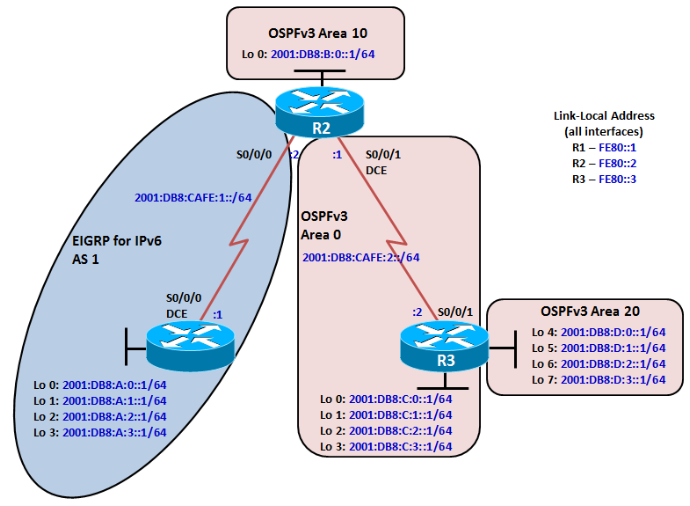
- •Chapter 4 Lab 4-3, Redistribution Between eigrp for iPv6 and ospFv3
- •Required Resources
- •Step 1: Configure loopbacks and assign addresses.
- •Step 2: Configure eigrp for iPv6.
- •Step 3: Manually summarize with eigrp for iPv6.
- •Step 4: Configure ospFv3 Address Family.
- •Step 5: Configure mutual redistribution between ospFv3 and eigrp for iPv6.
- •Device Configurations (Instructor version) Router r1
- •Router r2
- •Router r3
CCNPv7 ROUTELab 4-2, Redistribution Between EIGRP for IPv6 and OSPFv3

CCNPv7 ROUTE
Chapter 4 Lab 4-3, Redistribution Between eigrp for iPv6 and ospFv3
Instructor Version
Topology

Objectives
Review EIGRP and OSPF configuration.
Summarize routes in EIGRP.
Summarize in OSPF at an ABR and an ASBR.
Redistribute into EIGRP.
Redistribute into OSPF.
Background
Two online booksellers, Example.com and Example.net, have merged and now need a short-term solution to inter-domain routing. Since these companies provide client services to Internet users, it is essential to have minimal downtime during the transition.
Example.com isrunning EIGRP while Example.net is running a multi-area OSPF. Because it is imperative that the two booksellers continuously deliver Internet services, you should bridge these two routing domains without interfering with each router’s path through its own routing domain to the Internet.
The CIO determines that it is preferable to keep the two protocol domains shown in the diagram during the transition period, because the network engineers on each side need to understand the other’s network before deploying a long-term solution. Redistribution will be a short-term solution.
In this scenario, R1 and R2 are running EIGRP while R2 is the OSPF autonomous system border router (ASBR) consisting of areas 0, 10, and 20. You need to configure R2 to enable these two routing protocols to interact to allow full connectivity between all networks.
In this lab, R1 is running EIGRP and R3 is running multi-area OSPF. Your task is to configure redistribution on R2 to enable these two routing protocols to interact, allowing full connectivity between all networks. In Appendix A of this lab, you explorethe black hole operation.
Note:This lab uses Cisco 1941 routers with Cisco IOS Release 15.2 with IP Base.Depending on the router or switch model and Cisco IOS Software version, the commands available and output produced might vary from what is shown in this lab.
Required Resources
3 routers (Cisco IOS Release 15.2 or comparable)
Serial and Ethernet cables
Step 1: Configure loopbacks and assign addresses.
Configure all loopback interfaces on the three routers in the diagram. Configure the serial interfaces with the IP addresses, bring them up, and set a DCE clock rate where appropriate.
R1(config-line)# interface Loopback0
R1(config-if)# ipv6 address 2001:db8:A:0::1/64
R1(config-if)# exit
R1(config)# interfaceLoopback1
R1(config-if)# ipv6 address 2001:db8:A:1::1/64
R1(config-if)# exit
R1(config)# interface Loopback2
R1(config-if)# ipv6 address 2001:db8:A:2::1/64
R1(config-if)# exit
R1(config)# interface Loopback3
R1(config-if)# ipv6 address 2001:db8:A:3::1/64
R1(config-if)# exit
R1(config)# interface serial 0/0/0
R1(config-if)# ipv6 address 2001:db8:cafe:1::1/64
R1(config-if)# ipv6 address fe80::1 link-local
R1(config-if)# clock rate 64000
R1(config-if)# no shutdown
R1(config-if)# exit
R1(config)#
*Oct 27 10:01:40.307: %LINEPROTO-5-UPDOWN: Line protocol on Interface Loopback0, changed state to up
*Oct 27 10:01:40.711: %LINEPROTO-5-UPDOWN: Line protocol on Interface Loopback1, changed state to up
*Oct 27 10:01:41.123: %LINEPROTO-5-UPDOWN: Line protocol on Interface Loopback2, changed state to up
R1(config)#
*Oct 27 10:01:41.435: %LINEPROTO-5-UPDOWN: Line protocol on Interface Loopback3, changed state to up
R1(config)#
*Oct 27 10:01:43.439: %LINK-3-UPDOWN: Interface Serial0/0/0, changed state to down
R1(config)#
R1(config)#
*Oct 27 10:02:05.419: %LINK-3-UPDOWN: Interface Serial0/0/0, changed state to up
*Oct 27 10:02:06.419: %LINEPROTO-5-UPDOWN: Line protocol on Interface Serial0/0/0, changed state to up
R1(config)# exit
R1#
R2(config)# interface Loopback0
R2(config-if)# ipv6 address 2001:db8:B:0::1/64
R2(config-if)# exit
R2(config)#
R2(config)# interface serial 0/0/0
R2(config-if)# ipv6 address 2001:db8:cafe:1::2/64
R2(config-if)# ipv6 address fe80::2 link-local
R2(config-if)# no shutdown
R2(config-if)# exit
R2(config)#
R2(config)# interface serial 0/0/1
R2(config-if)# ipv6 address 2001:db8:cafe:2::1/64
R2(config-if)# ipv6 address fe80::2 link-local
R2(config-if)# clock rate 64000
R2(config-if)# no shutdown
R2(config-if)# exit
R2(config)#
R3(config)# interface Loopback0
R3(config-if)# ipv6 address 2001:db8:C:0::1/64
R3(config-if)# exit
R3(config)# interface Loopback1
R3(config-if)# ipv6 address 2001:db8:C:1::1/64
R3(config-if)# exit
R3(config)# interface Loopback2
R3(config-if)# ipv6 address 2001:db8:C:2::1/64
R3(config-if)# exit
R3(config)# interface Loopback3
R3(config-if)# ipv6 address 2001:db8:C:3::1/64
R3(config-if)# exit
R3(config)# interface Loopback4
R3(config-if)# ipv6 address 2001:db8:D:0::1/64
R3(config-if)# ipv6 address fe80::3 link-local
R3(config-if)# exit
R3(config)# interface Loopback5
R3(config-if)# ipv6 address 2001:db8:D:1::1/64
R3(config-if)# ipv6 address fe80::3 link-local
R3(config-if)# exit
R3(config)# interface Loopback6
R3(config-if)# ipv6 address 2001:db8:D:2::1/64
R3(config-if)# ipv6 address fe80::3 link-local
R3(config-if)# exit
R3(config)# interface Loopback7
R3(config-if)# ipv6 address 2001:db8:D:3::1/64
R3(config-if)# ipv6 address fe80::3 link-local
R3(config-if)#
R3(config)# interface serial 0/0/1
R3(config-if)# ipv6 address 2001:db8:cafe:2::2/64
R3(config-if)# ipv6 address fe80::3 link-local
R3(config-if)# clock rate 64000
R3(config-if)# no shutdown
R3(config-if)# exit
R3(config)#
Issue the show ipv6 interface brief command on each router and filter to include only the interface in an “up” status. Router R1 is shown as an example.
R1# show ipv6 interface brief | include up
Serial0/0/0 [up/up]
Loopback0 [up/up]
Loopback1 [up/up]
Loopback2 [up/up]
Loopback3 [up/up]
R1#
Verify that you can ping across the serial links when you are finished. Use the following Tcl script to check full and partial connectivity throughout this lab.
R1# tclsh
foreach address{
2001:db8:cafe:1::1
2001:db8:cafe:1::2
2001:db8:A:0::1
2001:db8:A:1::1
2001:db8:A:2::1
2001:db8:A:3::1
2001:db8:B:0::1
2001:db8:cafe:2::1
2001:db8:cafe:2::2
2001:db8:B:0::1
2001:db8:C:0::1
2001:db8:C:1::1
2001:db8:C:2::1
2001:db8:C:3::1
2001:db8:D:0::1
2001:db8:D:1::1
2001:db8:D:2::1
2001:db8:D:3::1
} { ping $address }
Which pings are successful and why?
At this point, only directly connected interfaces will be successful. For example, R1 should be successfully pinging the first six IPv6 addresses in the list and failing for all other IPv6 addresses as they are not on directly connected networks.
